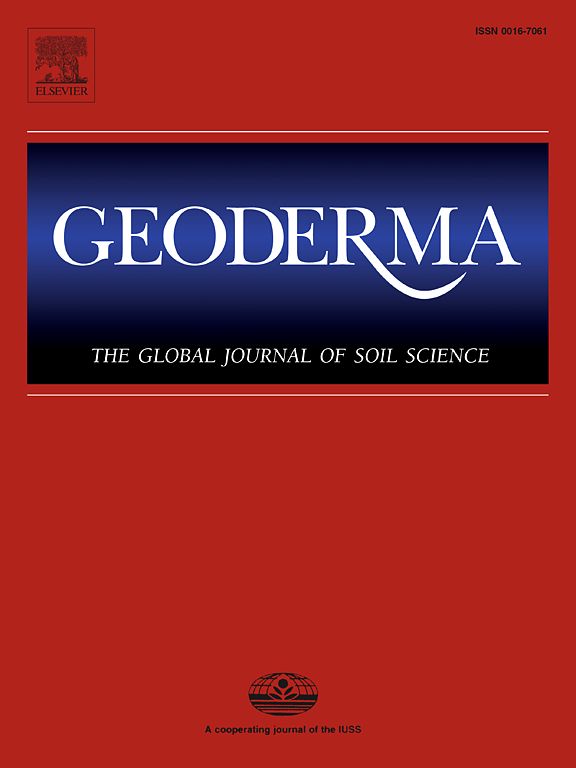25 年养护管理后集约化农业的土壤碳变化
IF 6.6
1区 农林科学
Q1 SOIL SCIENCE
引用次数: 0
摘要
土壤有机碳(SOC)和氮(SON)的变化受土地管理的影响很大,但很少有长期比较研究对整个土壤剖面的变化进行调查。我们对美国上中西部一个地点的 10 个重复生态系统中 1 米范围内 25 年的 SOC 和 SON 变化进行了量化。我们比较了玉米(Zea mays)-大豆(Glycine max)-冬小麦(Triticum aestivum)轮作中的四种一年生耕作制度,每种制度的管理方式都不同(常规、免耕、减少投入和生物);三种多年生管理制度(杂交白杨(Populus × euramericana)、紫花苜蓿(Medicago sativa)和针叶林(Pinus spp.三种演替系统(早期、中期和晚期演替,物种组成和结构随时间逐渐变化)。减少投入系统和以生物为基础的系统都包括冬季覆盖作物。在 25 年的时间里,传统演替系统和晚演替系统的 SOC 和 SON 都没有发生显著变化。所有其他系统都在不同程度上增加了 SOC 和 SON。早期演替系统的 SOC 增长最快(0.8 ± 0.1 兆克碳公顷-年-1),其次是紫花苜蓿和针叶林系统(平均 0.7 ± 0.1 兆克碳公顷-年-1)、杨树系统、减少投入系统和生物系统(平均 0.4 ± 0.1 兆克碳公顷-年-1),以及中期演替系统和免耕系统(分别为 0.3 和 0.2 兆克碳公顷-年-1)。在最近的 12 年中,除减少投入和中继性耕作外,所有耕作制度的 SOC 增长率都有所减缓。在包括免耕在内的任何系统中,都没有证据表明 SOC 在深层流失。按照紫花苜蓿≥早期演替系统、减少投入和基于生物的系统≥杨树系统、免耕和针叶林系统、中期演替系统的顺序,SON 的累积率介于 64.7 至 0.8 千克氮/公顷/年之间。传统、早期和晚期演替系统中的热原碳含量相似,尽管早期演替系统中每年焚烧 17 年(平均 50 厘米以下的 SOC 含量为 15%,50 至 100 厘米的 SOC 含量为 40%)。研究结果强调了覆盖作物、多年生作物和免耕方案对于在集约化管理的耕地中封存全剖面碳的重要性。本文章由计算机程序翻译,如有差异,请以英文原文为准。
Soil carbon change in intensive agriculture after 25 years of conservation management
Changes in soil organic carbon (SOC) and nitrogen (SON) are strongly affected by land management but few long-term comparative studies have surveyed changes throughout the whole soil profile. We quantified 25-year SOC and SON changes to 1 m in 10 replicate ecosystems at an Upper Midwest, USA site. We compared four annual cropping systems in maize (Zea mays)-soybean (Glycine max)-winter wheat (Triticum aestivum) rotations, each managed differently (Conventional, No-till, Reduced input, and Biologically based); in three managed perennial systems (hybrid Poplar (Populus × euramericana), Alfalfa (Medicago sativa), and Conifer (Pinus spp.); and in three successional systems (Early, Mid- and Late succession undergoing a gradual change in species composition and structure over time). Both Reduced input and Biologically based systems included winter cover crops. Neither SOC nor SON changed significantly in the Conventional or Late successional systems over 25 years. All other systems gained SOC and SON to different degrees. SOC accrual was fastest in the Early successional system (0.8 ± 0.1 Mg C ha−1 y−1) followed by Alfalfa and Conifer (avg. 0.7 ± 0.1 Mg C ha−1 y−1), Poplar, Reduced input, and Biologically based systems (avg. 0.4 ± 0.1 Mg C ha−1 y−1), and Mid-successional and No-till systems (0.3 and 0.2 Mg C ha−1 y−1, respectively). Over the most recent 12 years, rates of SOC accrual slowed in all systems except Reduced input and Mid-successional. There was no evidence of SOC loss at depth in any system, including No-till. Rates of SON accrual ranged from 64.7 to 0.8 kg N ha−1 y−1 in the order Alfalfa ≥ Early successional > Reduced input and Biologically based ≥ Poplar > No-till and Conifer > Mid-successional systems. Pyrogenic C levels in the Conventional, Early, and Late successional systems were similar despite 17 years of annual burning in the Early successional system (∼ 15 % of SOC to 50 cm, on average, and ∼40 % of SOC from 50 to 100 cm). Results underscore the importance of cover crops, perennial crops, and no-till options for sequestering whole profile C in intensively managed croplands.
求助全文
通过发布文献求助,成功后即可免费获取论文全文。
去求助
来源期刊

Geoderma
农林科学-土壤科学
CiteScore
11.80
自引率
6.60%
发文量
597
审稿时长
58 days
期刊介绍:
Geoderma - the global journal of soil science - welcomes authors, readers and soil research from all parts of the world, encourages worldwide soil studies, and embraces all aspects of soil science and its associated pedagogy. The journal particularly welcomes interdisciplinary work focusing on dynamic soil processes and functions across space and time.
 求助内容:
求助内容: 应助结果提醒方式:
应助结果提醒方式:


